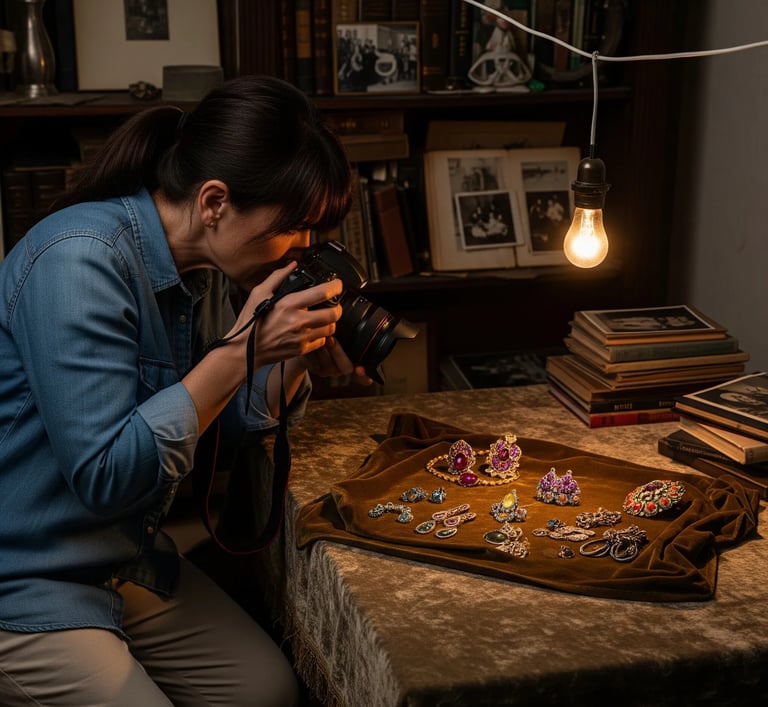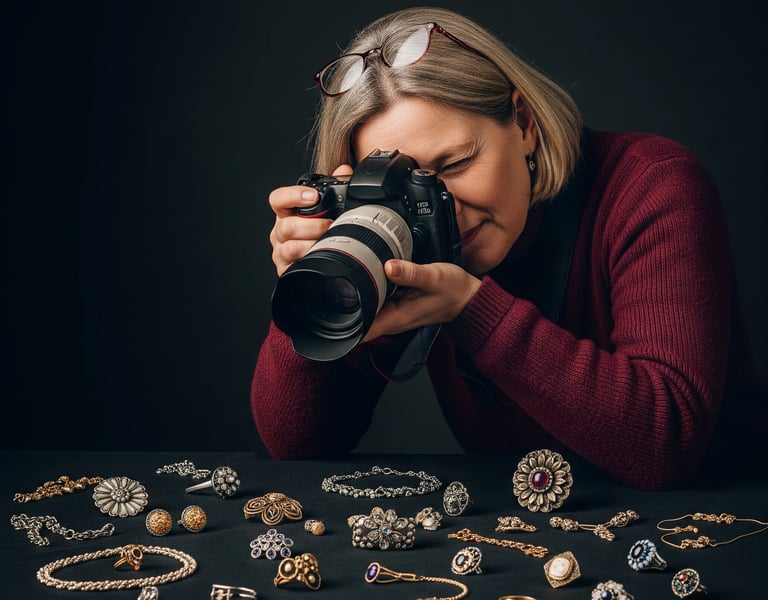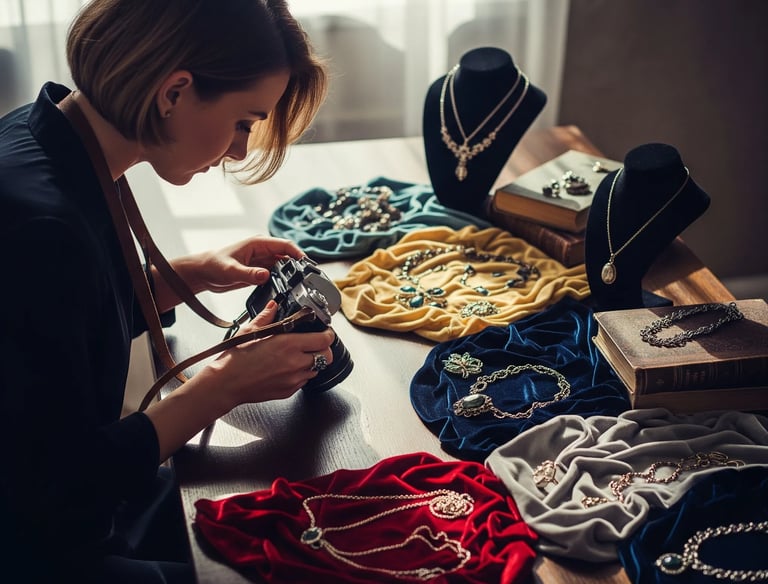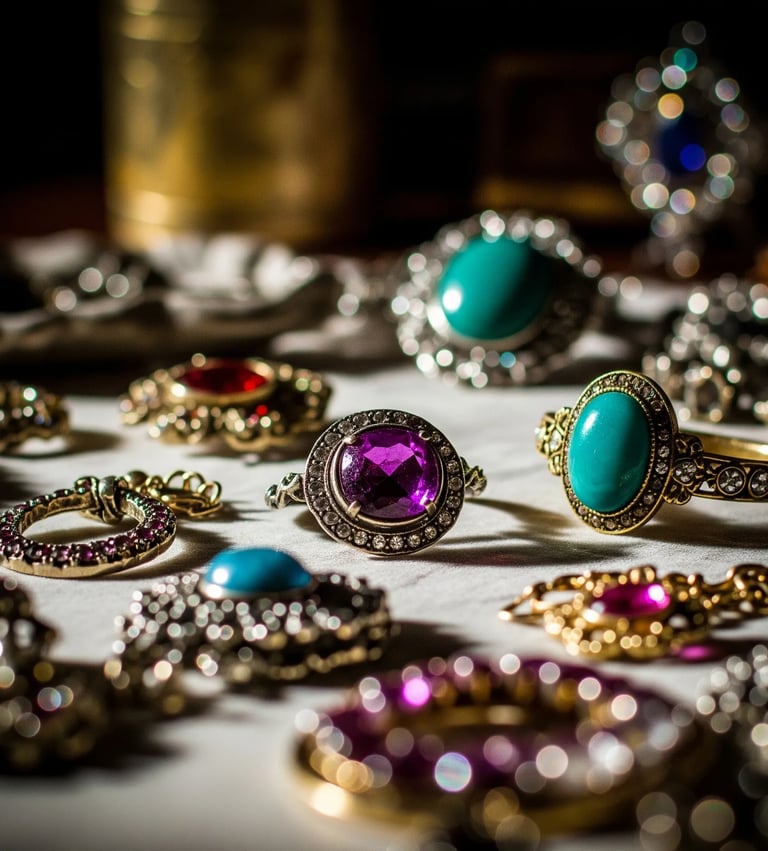5 Big Mistakes to Avoid When Shooting Antique Jewelry
Snapping antique jewelry? Avoid these 5 common slip-ups to capture their true charm and vintage beauty like a pro.
JEWELRY
7/20/20257 min read
Antique jewelry photography requires attention to detail and an understanding of the unique features of vintage pieces. Taking these timeless items means highlighting their charm and intricate designs. Antique jewelry often features delicate craftsmanship, unique gemstones, and historical significance, all of which necessitate an approach that goes beyond standard photography techniques.
The challenges associated with photographing antique jewelry can be significant. The reflective surfaces of metals and gemstones can create distractions that obscure the piece's inherent beauty. Vintage items often have imperfections that add to their character. These must be captured carefully in photos so they aren’t mistaken for flaws. Understanding how to manipulate lighting, angles, and backgrounds is important for showcasing the allure of antique jewelry effectively.
Taking vintage jewelry requires both technical skill and an appreciation for its history. Each piece reflects a different era, style, or craftsmanship. Great photography highlights these details, helping buyers or admirers connect with the jewelry's rich story.
By carefully lighting and framing the pieces, photographers can take the true charm of these collectibles. It's also important to avoid common mistakes that can reduce their visual appeal. Understanding these pitfalls will empower photographers to enhance their techniques and produce compelling imagery that resonates with viewers.
Poor Lighting Choices
The role of lighting in antique jewelry photography cannot be overstated. A well-lit photograph can accentuate the intricate details and vibrant colors of vintage pieces, providing a glimpse into their unique charm. Conversely, poor lighting can obscure these elements, casting unflattering shadows and creating an overall dull appearance. To take the true essence of antique jewelry, it is essential to consider both natural and artificial light options.
Ignoring Background and Props
Choosing the right background and props is key to showing the true beauty of antique jewelry. A common mistake is using cluttered backgrounds that distract from the jewelry. Such environments can confuse the viewer and overshadow the intricate details and craftsmanship that antique jewelry offers. Therefore, it is important to create a setting that accentuates rather than competes with the vintage items being photographed.
Choosing an appropriate background is important for enhancing the visual appeal of antique jewelry. Neutral backgrounds like soft fabrics or textured surfaces help the jewelry stand out. Colors like cream, light gray, or soft pastels create contrast with the detailed finishes of vintage pieces. Using natural elements, like earthy tones or wood, can also highlight the jewelry's history.
Disregarding Camera Settings
Camera settings like aperture, ISO, and shutter speed are important for taking the details and charm of antique jewelry. Many beginners overlook these settings, but they are key to showcasing the jewelry's true beauty.
Aperture controls the amount of light entering the camera lens and is important for creating depth of field. A wide aperture (lower f-stop number) can beautifully blur the background, making the antique piece stand out. This is particularly effective in showcasing the detailed textures and craftsmanship of intricate designs. A narrower aperture keeps more of the scene in focus, which is useful when photographing multiple pieces. Understanding how to balance aperture with the lighting conditions is essential for optimal results.
ISO settings determine the camera's sensitivity to light. In low-light situations, such as indoors or during evening shoots, a higher ISO can help avoid underexposed images. However, it is important to be cautious, as a high ISO can introduce unwanted noise or graininess. For better results, aim for the lowest possible ISO that still allows for an adequately exposed image. This helps maintain the elegance and fine details of each antique piece.
Shutter speed is another significant factor that should not be overlooked. A fast shutter speed prevents motion blur and improves clarity, especially with reflective jewelry. In low light, you may need a slower shutter speed with a low ISO and wide aperture, so using a tripod is important to keep the camera steady. Balancing these settings will result in attractive photos that take the true essence of antique jewelry.
Neglecting Detail Shots
When photographing antique jewelry, one of the most common errors is the oversight of detail shots. Wide shots provide context but don’t take the intricate details that make vintage jewelry special. Antique jewelry is valued for both its history and the fine details that may be missed in wider photos. Therefore, integrating a variety of compositions, especially close-ups, is essential for exhibiting the true charm of each piece.
Poor Post-Editing Practices
Post-editing is an important phase in the photography process that can significantly affect how antique jewelry is represented in images. Unfortunately, many photographers, whether novice or experienced, fall prey to common errors at this stage. One prevalent mistake is over-editing—excessively altering the original image to the point where the jewelry's authentic charm is lost. Images can end up appearing overly artificial or unrealistic. When showcasing vintage pieces, it’s essential to strike a balance between enhancement and authenticity.
Another common error is neglecting color correction. Antique jewelry often features intricate details and a diverse color palette that can become distorted due to lighting conditions during photography. Failing to address these discrepancies can lead to representations that are misleading, as the colors may not accurately reflect the true essence of the piece. Investing time in color correction tools within editing software can ensure that the hues and shades are presented faithfully.
When editing antique jewelry photographs, several software options can support the process effectively. Programs like Adobe Lightroom and Photoshop are ideal due to their comprehensive tools for fine-tuning images. Such platforms allow photographers to adjust brightness, contrast, and color balance with precision, helping to enhance the jewelry's visual appeal without overwhelming it. Additionally, utilizing features like the histogram can guide adjustments and aid in achieving a balanced composition.
Taking the charm and beauty of antique jewelry requires a keen eye and knowledge of photography techniques. Throughout this blog post, we have explored essential tips to avoid common mistakes that can detract from the elegance of your pieces. First and foremost, lighting plays a important role in bringing out the intricate details and colors of antique jewelry. Using natural light or soft diffused lighting can significantly improve the overall image quality. Make sure the background complements the jewelry, not competes with it, to make the piece stand out.
Next, we highlighted the importance of using the right camera settings, like adjusting the aperture and shutter speed for a clear shot. Employing a tripod can also help stabilize your camera, eliminating the risk of blurriness during exposure. Moreover, developing an eye for detail is fundamental; considering the angle and perspective can create dynamic and captivating compositions that highlight the jewelry's craftsmanship.
As you experiment with your antique jewelry photography, remember that practice is vital. Try out different techniques and styles until you discover what resonates best with your artistic vision. Embrace the learning process and allow yourself the freedom to innovate. Taking antique jewelry takes patience and attention to detail, but with practice, your skills will improve over time. Ultimately, whether you are a novice or an experienced photographer, the journey towards learning antique jewelry photography is one filled with creativity and discovery.
Natural light, especially during the golden hour, creates soft, warm lighting for great photos. Placing jewelry near a window can work well, but avoid direct sunlight to prevent overexposure and faded colors. Utilizing a sheer curtain can diffuse the light, providing an even illumination that highlights the piece's intricate craftsmanship.
On the other hand, artificial lighting can also be effective when photographing antique jewelry in controlled environments. Softbox lights or LED panels offer steady lighting and can be adjusted for brightness and color to highlight the jewelry's features. Including reflectors in your setup can help bounce light onto the piece, reducing shadows and enhancing details.
Using diffusers helps reduce light reflections on shiny surfaces, giving a clearer view of the piece's design. When utilizing multiple light sources, ensure that they are balanced to avoid creating unpleasant color casts or harsh contrasts. Taking the time to learn lighting will greatly improve your antique jewelry photos, making their vintage beauty stand out. With practice, you can transform ordinary shots into attractive images.
Moreover, props can either enhance or undermine the overall composition. Using props that relate to the theme of vintage jewelry—such as antique books, delicate lace, or timeworn silver trays—can enhance storytelling in your photographic presentation. However, it is imperative to ensure that props do not overshadow the primary focus: the jewelry itself. Aim for simplicity; a single elegant prop that complements the thin filigree of a ring or the vibrant gemstones can add depth without causing distraction.
By picking the right background and props, photographers can show off the beauty and history of antique jewelry and helping viewers appreciate its design.
To highlight the details of antique jewelry, photographers should experiment with different angles. For instance, photographing gemstones from a lower angle can show their depth and sparkle. Macro photography helps take tiny details, like the wear on a ring or the designs on a pendant.
Moreover, consider including shots that reveal the piece’s texture. Showing the smoothness or texture of the jewelry highlights its age and history. Using different compositions makes the image more interesting and helps viewers appreciate the craftsmanship behind these timeless pieces.
When taking detail shots, make sure the lighting highlights features without causing glare. A diffused light source can help illuminate intricate designs without overshadowing them. Focusing on these key elements helps take the vintage beauty of antique jewelry and tell their unique stories.
Make small adjustments, like sharpening or brightening the exposure, while keeping the jewelry's colors and textures intact. These tweaks will improve the photos and preserve the jewelry’s vintage beauty.
Conclusion








Follow
marketing@photostudioretoucher.com
+1 568-472-9510
Services
Sub Services We Offer

